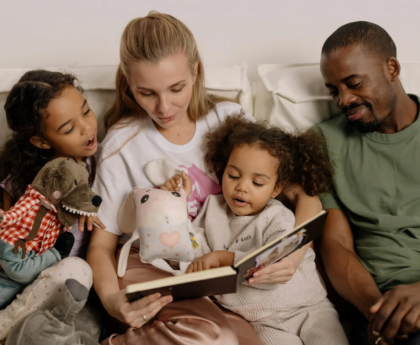Walter Dean Myers was a beloved children’s author who wrote over 100 books for young people. He grew up in Harlem, New York, and loved reading from an early age. As a child, he struggled with a speech impediment that made him shy about speaking in class, but he found his voice through writing stories. Myers wrote wonderful picture books for young children like “Looking Like Me” and “Harlem,” as well as books for older readers. His stories often featured diverse characters and real-life situations that many children could relate to.
What makes Myers’ books special is how they show children of all backgrounds that their stories matter. For young readers just beginning their reading journey, his picture books provide colorful, engaging stories with characters who look like them and experiences they might recognize. His work earned many awards, including the Coretta Scott King Award and the Newbery Honor. Myers also served as the National Ambassador for Young People’s Literature, where he championed the message “Reading is not optional” – a philosophy we strongly believe in at Reading.com!
The Power of Diverse Books for Early Readers
When preschoolers and early readers see themselves in books, something magical happens. For young children just learning letter sounds and beginning to decode words, the motivation to continue practicing comes from connecting emotionally with the stories they read.
Walter Dean Myers understood this deeply. In his picture books, he created characters and situations that reflected the lives of all children, particularly those from urban environments who were historically underrepresented in children’s literature. This representation matters enormously in early literacy development.
When children ages 3-6 see characters who look like them or share similar experiences, they’re more likely to:
- Feel that reading is personally relevant to their lives
- Develop positive associations with books and reading time
- Build confidence in their emerging reading abilities
- Engage more deeply with story comprehension
For parents of emerging readers, introducing diverse books like Myers’ “Looking Like Me” or “Harlem” alongside phonics practice creates a powerful combination. While children learn the mechanics of reading through structured phonics lessons, they develop reading motivation through engaging with meaningful, representative stories. This combined approach addresses both the “how” and the “why” of reading – technical skills alongside purpose and enjoyment.
How to Share Walter Dean Myers with Your Early Reader
Introducing Walter Dean Myers to your preschooler or early reader doesn’t require them to read independently. Here are practical ways to incorporate his work into your child’s literacy development:
Start with picture books: Myers wrote several beautiful picture books perfect for young children. “Looking Like Me” celebrates self-acceptance with rhythmic text that’s perfect for read-alouds. “Harlem” is a poetic tribute to this historic neighborhood with vivid illustrations that captivate young imaginations. These books work wonderfully as bedtime stories or special reading time selections.
Use dialogic reading techniques: When sharing Myers’ books, engage your child with questions about the illustrations and characters. Ask them what they notice, how the characters might feel, or what might happen next. This interactive approach builds comprehension skills alongside phonological awareness.
Connect to phonics practice: After reading one of Myers’ picture books together, pick out a few simple words from the story to use in your phonics practice. For example, if you’ve read “Harlem,” you might focus on words beginning with the ‘h’ sound. This bridges the joy of storytelling with the technical aspects of learning to read.
Create extension activities: Extend the reading experience with simple related activities. After reading “Looking Like Me,” help your child create a self-portrait and label it with simple words describing themselves. This reinforces both the book’s message and literacy skills.
Remember that early reading experiences should balance structured skill-building with joyful engagement. Walter Dean Myers’ work provides the perfect foundation for that balanced approach.
Build a Diverse Early Reading Library
Walter Dean Myers’ books make an excellent starting point for creating a diverse early reader library, but expanding beyond his work is important, too. Young children benefit from seeing a wide range of characters, settings, and experiences in their books.
When selecting books for your emerging reader, consider including:
- Books featuring characters from various racial and cultural backgrounds
- Stories showing different family structures
- Characters with various abilities and challenges
- Books set in different environments (urban, rural, international settings)
- Stories that subtly address social issues in age-appropriate ways
For preschoolers and early readers specifically, look for books with clear, vibrant illustrations, relatively simple text, and engaging storylines. These features support visual literacy alongside decoding skills.
As you build this library, remember that the goal isn’t just exposure to diversity—it’s helping your child develop both the technical skills needed for reading success and a genuine love of books. Walter Dean Myers believed passionately that all children deserve stories that reflect their experiences and expand their horizons.
Connect Myers’ Legacy to Reading Development
Walter Dean Myers often spoke about how books saved his life. As a child with a speech impediment who struggled in school, he found refuge and purpose in reading. This personal experience informed his mission to write books that would reach children who might otherwise feel excluded from the world of literature.
For parents of emerging readers, Myers’ story offers an important reminder: reading development isn’t just about mastering phonics and decoding. It’s about finding meaningful connections to books that make children want to persist through the challenges of learning to read.
The Science of Reading emphasizes that effective reading instruction must include systematic phonics alongside rich exposure to vocabulary and comprehension-building activities. Myers’ picture books support this balanced approach beautifully. While you’re teaching your child letter-sound relationships and blending skills, Myers’ engaging stories provide the meaningful context that makes those technical skills worth acquiring.
When children connect emotionally with books like Myers’, they develop what reading researchers call “reading motivation” – the internal drive to engage with text even when it’s challenging. This motivation becomes increasingly important as children progress from early decoding to more complex reading tasks.
Myers himself said, “Reading is not optional.” At Reading.com, we couldn’t agree more. We believe that by combining structured, systematic reading instruction with diverse, engaging literature like Myers’, we give children the best possible foundation for reading success.
Start Your Reading Journey with Walter Dean Myers
Ready to introduce your young reader to Walter Dean Myers’ wonderful world of books? Here are some simple steps to get started:
- Visit your local library and check out Myers’ picture books like “Looking Like Me,” “Harlem,” or “Blues Journey”
- Set aside special reading time where you can explore these books together
- Talk about the characters and illustrations, asking open-ended questions
- Point out letter patterns or sight words your child might recognize
- Connect the stories to your child’s own experiences through simple conversations
Myers and Early Reading Success
Walter Dean Myers’ legacy reminds us that diverse, engaging books play a crucial role in early literacy development. By introducing his work to your young reader, you’re not just exposing them to wonderful stories—you’re helping them see reading as personally meaningful and worth the effort.
As your child begins their reading journey, remember that both structured skill-building and joyful engagement with books matter. At Reading.com, our app supports this balanced approach, providing systematic reading instruction that parents and children can enjoy together.
Ready to support your child’s reading development with evidence-based methods and engaging content? Download the Reading.com app today and start your 7-day free trial. Together, we can help your child discover the joy and power of reading, just as Walter Dean Myers intended.





